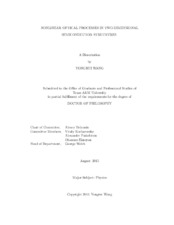| dc.description.abstract | The optical properties of two types of two-dimensional (2D) semiconductor structures are studied. One of them is for structures based on quantum wells (QWs), and the other is graphene. We study the dynamics of optically excited electron-hole plasma or magnetoplasma in uncoupled QW structure. Experimentally we have observed a delayed burst of optical pulse, or super fluorescence (SF). Time and energy-resolved measurement shows the center frequency of the pulse is red-shifting with time. We explain this by developing the generalized semiconductor Bloch equations (SBEs), where Coulomb interaction between electrons is taken into account. For electronhole plasma in quasi-equilibrium, the calculation shows the peak gain is near the Fermi-edge. So, the red-shifting is because of the decreasing of Fermi energy with time.
The effect of Coulomb interaction in intersubband transitions is also studied, where we have developed equations similar to the SBEs, and show that the Coulomb effect could enhance particular second-order nonlinear optical processes.
Quantum cascade lasers (QCLs) are well developed devices based on QWs. We study the active modulation in mid-infrared (mid-IR) QCLs. We show that QCLs with short gain recovery time can also generate short pulses by active modulation, while it is previously thought active modulation can only be applied for QCLs with long gain recovery time. Comparisons between the two cases show the performance of QCLs with short gain recovery time is more robust for active modulation. Also, mode-locking can be achieved by tuning the modulation period.
As a natural 2D material, graphene has linear energy dispersion near the Dirac points. This leads to interesting electronic and optical properties. Under Landau quantization, we propose a scheme for achieving continuous-wave terahertz (THz) gain by mid-IR pumping. In this scheme, scattering of surface-optical (SO) phonons from the substrate is utilized to populate the upper laser state. All the important scattering processes are calculated to justify the design. We also study the properties of second-harmonic generation (SHG) in graphene without magnetic field. The experimental measurement shows peculiar relations between the polarizations of fundamental light and second-harmonic (SH) light. We develop a quantum theory to explain the observations. | en |


